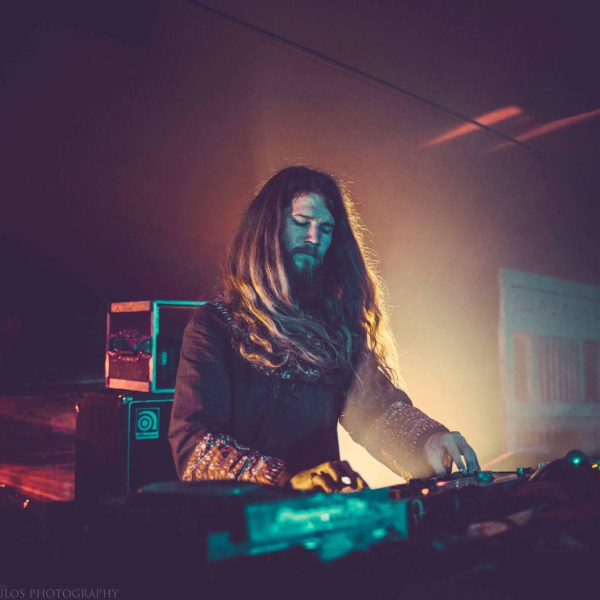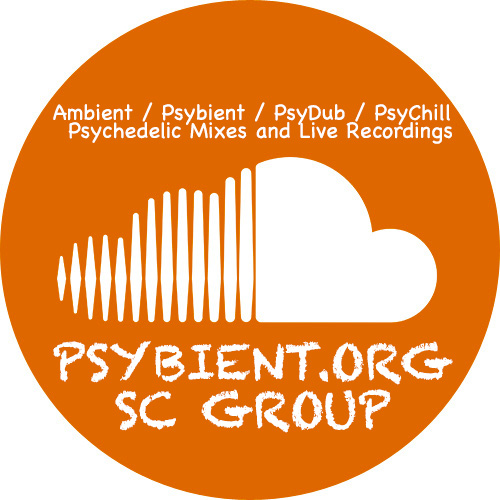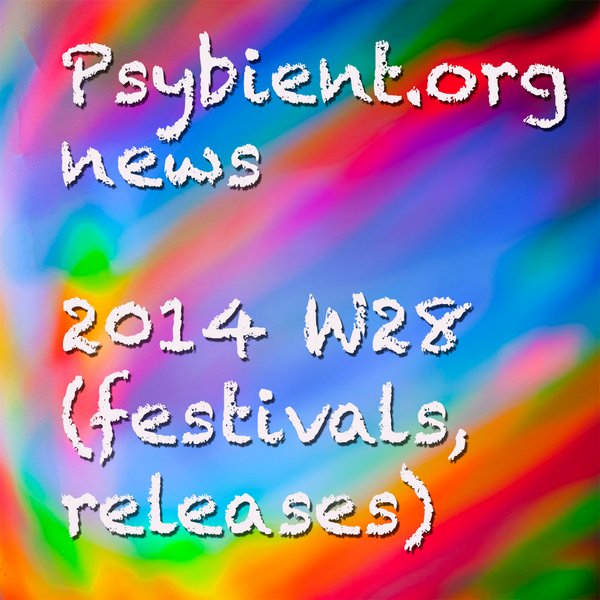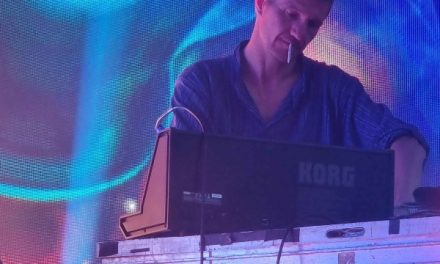And we continue our “interviews”. Today we are chatting with Erothyme!
Some topics: album story, influences.
Interview made by Sanjay Gopalkrishnan (FB, IG)
Introduction:
In ‘Steep Dreams’, the latest album from Bobby West aka Erothyme we find ourselves swimming through a lush undergrowth of sublime sonic awe that consists of graceful glitches and grunts, tender melodies and caressing synths with an underlying foundation of electroclassical euphoria.
Erothyme has a way with frequencies and words, which he uses to share emotional tales, and bare pieces of his soul by artfully combining field recordings from his surroundings with live instruments like the Rhodes, clarinet, violin, upright bass and last but not least, the human voice of course. Coaxing plugins and electronic instruments to come to life, he keeps these transmissions evergreen as much as he does the tradition of liner notes in albums, naturally combining overlapping art forms in worshipful reverence to the beauty of existence.
Just like all the energy, emotions and real life & cosmic events mould the frequencies of your being to create sounds through you, Steep Dreams is a conscious sonic culmination of the artist never falling to be humbled by the majesty of creation.
The Erothyme sound is a majestic blend of overblown hyperbole and meaningless adjectives that actually have nothing to do with music. His tracks land in your ear like a dolphin gracefully diving into the surface of the ocean after doing a triple backflip in front of the setting sun. Some people think that Erothyme doesn’t be like he is, but he do.
Erothyme douses all of his beats in multiplicitous melting layers of homebrewed extra-sultry sentimental sweetsauce.
All grooves transmitted via hyperlight communication from the creation station.
How’s it going in Colorado? How do you usually interact with the place and the music scene there?
Ahhh, the question “how’s it going” just hits different in 2020. ;)
At this moment, it is very smokey. A blanket of ash is shrouding the western United States, making many of us feel persistently tired, short of breath, irritated, even nauseated. My eyes have been burning and itching. We don’t have it nearly so bad as many other places do right now, as so many are experiencing displacement and loss and much higher levels of smoke exposure, but it’s still affecting everyone here, I think. Currently hoping and praying for copious amounts of rain, from the plains to the west coast…
Here in Boulder, we thankfully saw our Covid numbers drop quite low recently. However, just as things were getting under control, the annual wave of college students flooded in. Now there is constant partying happening, just down the road, and I’m fairly certain more people will be sick before long. You can catch me in the studio, keeping my distance from the sh**show, pretending I’m undergoing a long journey in a musical spaceship!
All that said, Colorado as a place feels very much like home to me. I love the elevation, the crisp dry air, the sunshine, the mountains, the openness, the tremendous sky. I draw a lot of inspiration just from being here.
It deserves to be mentioned that Denver is sort of the bass music capital. This is a highly connected place with a lot of opportunity, which is also very, very saturated with artists trying to make it. I’ve been here for years, and I still feel like I’ve barely tapped the local scene. Still even feel like a bit of an outsider. Hopefully that will change someday. Despite not playing music locally nearly as much as I would like, it’s great being surrounded by so much creative energy, and being here is still a convenient career decision for someone who likes to tour North America. At least, you know, before the pandemic, and hopefully after as well.
Overall I’m thankful to be here. Colorado was always a mythical promised land to me, growing up, and even after living in some incredible locations (up and down the west coast, and in Hawaii), I still feel more at home here than anywhere.
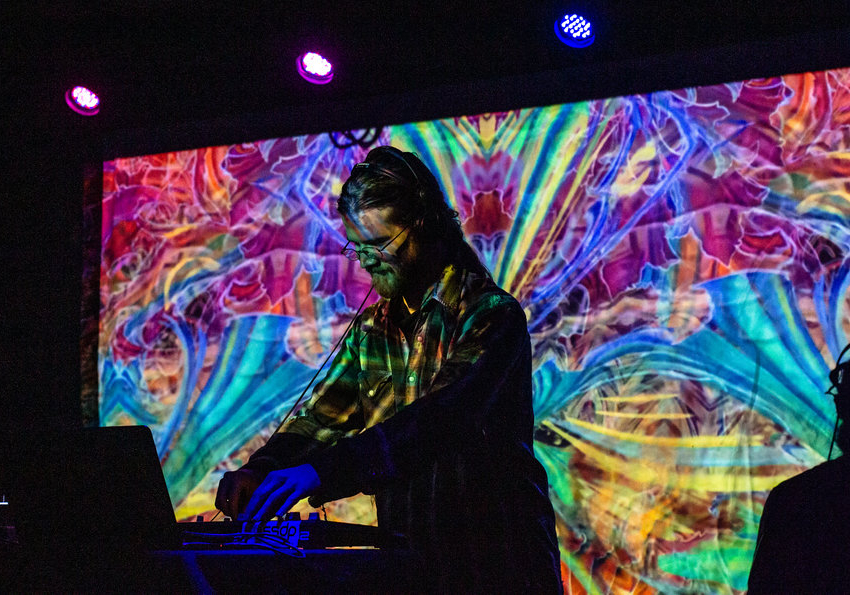
Can you tell us about the album theme and concept? {How the tracks are individual stories/episodes in themselves, and come together as a whole journey in form of the album}
The name Steep Dreams originally settled in because I was drinking a lot of tea. But the phrase came to mean several things to me throughout the time the album was being made. Steep could also refer to mountains, or to danger, risk, or expense. Dreams could be literal dreams, or they could be ambitions, or visions.
More than 50 different tracks were considered for the album during the time it was being created. Narrowing down what would be focused into this particular release was quite a challenge, and I spent many hours and many nights just exploring the possible arrangements for the tracklist, trying to get the arc just right. It can be a little bit like writing a novel or directing a movie. The flow of emotional intensity, and the patterns of tension and resolution, are very important in shaping the listening experience. Sometimes this is related to the personal meaning each song holds for me, sometimes it’s more just about how the songs feel on the surface – most of the time, it’s a little of both.
In this particular case, the narrative arc follows a period of upheaval, betrayal, soul-searching, and renewed self-discovery in my personal life. I will spare you the details, in my opinion it really doesn’t need a verbal explanation in order to be relatable! That whole pattern is, after all, a tale as old as time.
Many of the tunes from the past couple years which didn’t end up on Steep Dreams are now growing into new branches of their own! I’ve mapped them into at least 8 distinct categories to guide myself through the curation of future releases. Meanwhile, new songs can emerge in the blink of an eye, and sometimes change the way I think about the tunes which already exist. If I live long enough and society doesn’t collapse, there is a lot more Erothyme on the horizon!
What does the cover art signify?
The cover art is an ink drawing by Emily Kell called Mountain Moon! She used this drawing as a design on some pretty sweet T shirts, one of which I happen to own. When the album was nearing completion, I was trying to find the right cover art. At one point I was listening to the tracks while wearing my Mountain Moon shirt, saw the design in the mirror, and it just clicked that we had a match. Something about the way this drawing stares into the viewer’s soul, and something about the astro-mythic dreamscape that it depicts, matches the mood and the emotional intensity of the music, in my mind.
It didn’t occur to me until later how well the names “Mountain Moon” and “Steep Dreams” match each other.
BTW Emily is printing more of those shirts now, to sell on her etsy page, including some with the white-on-black color scheme, like the Steep Dreams album cover. Just saying!
What was your process of finding/creating your own sonic identity from all your musical/non-musical influences and your life’s journey?
It’s still going on!
I feel the need, as an artist, to always pay attention to what I’m really feeling, and what really speaks to me musically, which obviously changes and develops over time. As long as I stay in tune with that real-time feedback loop, I believe the music will keep transforming, keep finding itself, and keep responding to new & old influences, from a fresh angle.
It’s hard to imagine finding one mood or sound palette or tempo I like and just sticking to that. I respect anyone’s choice to focus on a single formula or technique, I even see that practice as important for music, and we all certainly repeat ourselves sometimes. But personally I don’t think I could keep my heart in it forever.
So I’m striving to always feel like a curious beginner, with each new wave of music, because that spirit is more important to me than feeling like I know exactly what is going to happen ahead of time.
Someone asked one of my favorite musicians, “will you ever make another album like [x]?”
He replied, “no, but you can!”
Could you tell us about your sound selection & design process: synthesis, foley from everyday life, creative sounds like Craftal’s Circuit bent butterfly wand on Track 1 ; Jacket zipper scratch solo on Tracks 6 & 7) and how they are imbibed into your tracks.
I have a tendency to get pretty sentimental about my sound choices. They will sometimes be symbolic to me, or related to a particular memory, person, time, or place that has something to do with the meaning or mood of the song. Aside from just adding character to the music, this can have the very practical effect of serving as emotional anchor points for me while creating. I think of it like having constant subliminal reminders to keep me in tune with the feeling I’m intending to explore, process, or cultivate… keeping me in the right mood by association.
For those reasons, I like to gather sounds with a portable field recording microphone, and those recordings become the raw material for many of the sounds in my music. When you’ve got a field recording microphone on you, everything you hear in the world becomes your sample library. And every recording, of course, is a memory. This practice really had an effect on the way I listen to sounds in everyday life.
That doesn’t mean every single sound has some kind of deep and premeditated meaning integral to each track. But certainly some of them do, for me.
Re: the Craftal cameos, Ian and I had a sound design session back in January, during which both of those sounds were recorded and edited. We both walked away with those edited recordings, and I later edited them further to be included in the tracks you mentioned. In the track Steep Dreams, the circuit bent sounds make me feel like a dial-up modem connecting to the cosmic interwebs. In Strong Tea, I imagine the zipper fractal just rhythmically zipping and unzipping my mind’s eye, sometimes hundreds of times a second. Just a bit of fun! ;)
How has your journey as multi-instrumentalist-producer been in regard to learning to play various instruments and incorporating them into your music?
I love to play instruments, it feels amazing to have music just flow out of your hands. It’s a great way to get the music flowing, viscerally, intuitively, in real time. I still consider myself more of a producer/composer than anything else. With the singular exception of clarinet, learning to produce electronic music came before learning to play instruments for me. At the end of the day, everything else I do with music ends up woven back into the production process. Every new way I learn to make music gives me another point of perspective about music itself. Having more ways of expressing yourself means having more creative freedom.
I also really enjoy creating while learning. Combining ongoing creation with ongoing education makes both processes more engaging, more of an adventure. It’s tempting to separate the two, and think of learning a technique/concept, and then applying it, as being necessarily two separate activities, but personally I learn quicker and enjoy the creative process more if I’m reaching into the fringes of my abilities and understanding while I’m also in the act of composing.
Once you think you know exactly what you’re doing, there is a certain magical spark that becomes difficult to reclaim. Picking up new instruments and new tools, and setting out with determination to learn how to express yourself through them, is certainly helpful in the quest to maintain “beginner’s mind.”
All of us are noobs at something! We might as well accept it, and revel in it!
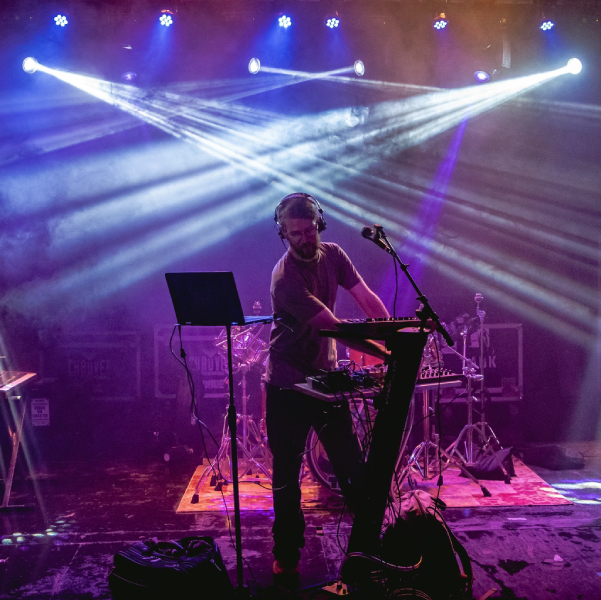
What does collaboration mean to you and how do they usually happen in your case? {8 of 11 tracks are with collaborators/features}
Collaboration is a creative choice!
Anyone who’s really in touch with their voice (whether literally or figuratively) will come up with things that I wouldn’t do on my own. For me it’s a way to have a creative conversation with friends, and a way to find some common threads in a groove. It’s also a way to create networks with people who otherwise might never meet or know of each other. Several of the tracks on the album contain parts contributed by people who live thousands of miles apart and have never been in the same room.
Usually they happen because there’s an element of mutual excitement, and we both know it’s gonna lead to something awesome being created!
Does music occur for you along with poetry and other art forms like visual art? What is this interaction like?
It’s all spun together!
I’ve always had a very visual relationship to music. I can’t help but envision geometric shapes, patterns, and textures related to the rhythms and tones I hear. Closing my eyes with headphones on has been a cherished activity for me since childhood!
Sometimes I suspect that I get more musical inspiration from the visual world than from listening to other music. I get filled with ideas when I look at natural landscapes, architecture, paintings, people, etc…
Words and phrases can spark musical ideas too, so I definitely keep lists of words that come to me, including sometimes little poems, which sometimes stimulate music-making. The connection between music and words varies from track to track, though. For example, some tracks are named before a single sound is laid down, other tracks aren’t named until after they’re done.
Something about playful, non-literal associations that cross between the senses feels intrinsically psychedelic to me.
Certainly feels less stuffy than thinking exclusively in terms of technique or music theory.
I was pleasantly surprised to find quite a bit of liner notes with the record which described very beautifully much of the conception of the record! Reminds me of when I would buy cassettes in the 90s and read every word in the liner notes :)
Totally, I’ve got some fond memories of digging into the booklets that came with CDs I bought as a teenager. And on Bandcamp, it seems you can cram quite a lot of words into the liner notes section, without even having to pay money to print more pages for your CD case insert!
At times, a little bit of context can really enhance the appreciation of a work of art. At other times, it can get in the way of the raw experience. This is sometimes a dilemma, when it comes to deciding how much to share about the process. But I’ve always valued and learned a lot from the artists who shared a little bit more of a window into their minds and creative processes, and I hope I can pass a little bit of that same inspiration along to others.
There sure are a lot more words in the Steep Dreams liner notes than there are on the album itself!
How do you feel about technology in music and the world as of the year 2020?
Music and technology have had a very close relationship for a very long time! The invention of the hunting bow, and the invention of the harp, are naturally quite closely connected. And as long as both music and technology have existed, new musical expressions and new technological developments have been met with not only excitement and awe, but also fear and criticism. Even the piano was criticized for “ruining music” when it was first invented. Don’t even get me started on the pushback recieved by jazz, rock, hiphop, and, of course, electronic music as a whole…
Let’s be real, you know if Bach had a machine that could flawlessly replicate any of his ideas, without having to hire diva musicians to interpret his intentions, he most likely woulda been all over that shit.
Now in 2020 it’s been a whole generation since we musicians were able to arbitrarily duplicate, transform, and recontextualize just about any sort of sound anyone has ever made. I think it’s becoming more and more apparent, in a world where so many of us have the tools at our fingertips, and sounds themselves are a dime a dozen, how important it is for artists to develop their authentic voice, and to express their authentic feelings. There isn’t much satisfaction to be had in participating in the pissing contest of determining who can be the loudest, edgiest, trippiest, most complex, even the most beautiful, you name it, unless those values themselves are truly integral to the artist’s authentic self-expression.
Very few people these days are making sounds that listeners haven’t heard before. What’s really important right now is how technology streamlines the creative process, what kinds of creative opportunities we have because of the technology at our fingertips, and how we choose to make use of those opportunities, in the effort to create art that speaks to the human soul.
Technology is an extension of the human will, the human mind, and the human body.
It is not separate from us, and never has been.
What is “being human” to you?
Being human is being adaptable and creative.
Being human is being capable of both great and terrible things.
Being human is being able to feel, and being able to empathize.
Being human is also being able to reason.
Being human is being inherently flawed but also inherently beautiful.
On the day that the track now known as Human Rising was started, I was having some really tough emotions, and a friend consoled me by saying, “it’s OK to be human, Bobby.” The ableton project then was titled “OK2BHuman.als” and this eventually led to the final title of the song.
Gratitude: It’s importance in our lives. How do you feel and express gratitude in your life?
I feel gratitude when I recognize how incredibly lucky we are to be alive, to feel, to create, to love, to dream, to despair, to rejoice.
Such incredible odds had to be overcome in order for our lives to be possible. So much had to happen in order for you or I to exist. It’s mind boggling that we are able to even have the experience of waking up day after day with a thread of consistent narrative in our existence.
To me, music is a big part of celebrating that miracle. That celebration happens through creating music, as well as the very act of listening and consciously experiencing it. It’s life-affirming enough to me that I feel committed to making and sharing it. At this point I have a hard time imagining myself personally selecting a different path through the world.
There are many ways to live in gratitude and celebrate life, and it takes many people walking many paths to keep this ship afloat. To everyone living in the spirit of reverence for life, whatever your contribution to the world, I thank you.
The act of making music with conscious intent : How do you do this?
There are many ways to make music, and many possible intentions that people can have for making it. I think that in some sense the intentions and feelings of the artist are embedded in the work, but that at the same time, artists only have a limited amount of control about what another person will experience, what they will take away, and how they will interpret it… whether or not the music has words.
Personally I find it important to keep a few things in my frame of reference as much as possible – staying in touch with the feeling of the music, making it something I really like, putting care into the details, remembering that music is a celebration of life.
When the flow state is really flowing, the feedback loop seems to take care of itself, and each choice made in the creative process cascades closer and closer to expressing the feeling inside the artist. There’s no catch-all technical formula for this, we’re always just getting hotter or getting colder, and using our internal compass to navigate toward a result we’re satisfied with.
“My greatest wish for this music
is that, should you choose to listen,
these tunes may bring you
some glimmer of joy, or
some flame of inspiration, or
some moment of release, or
some feeling of relief,
or that they even may simply
contribute to some good memory,
as they already have for me
on numerous occasions.”
When you look to a distant peak,
you may be having steep dreams.
To brew an inspired cup of tea,
you must steep dreams.
When you cultivate a vision,
you are steeped in dreams.
When your ambitions come with a price,
your dreams are steep.

